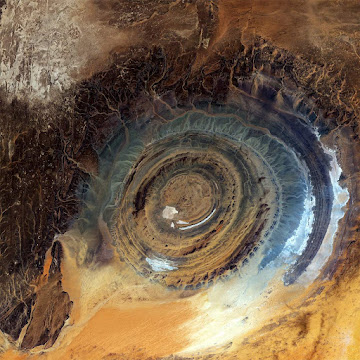The structure is amazing .but also geologically consistant. Quartxzite provides us the bones and rock rotting erodes out the softer sediments. add any old intrusive uplift and millions of years and it all works. Still unique in its own way, just like niagra and the grand Canyon. so yes, we can figure out how it came about and still say wow.
This was flooded by the passing river and then occupied by humanity. It was secure and huge and could readily support a massive popu;ation through fishing that local delta region. like being at poverty point on top of the mississippi delta.
none of this demanded human intervention or building skills, which you assume when reading the story of atlantis. this was an indiginous trading population that took advantage of what nature provided and that was good enough to anchor antidiluvian civilization globally. .
Richat Structure: Geological Wonder in the Sahara Desert
A geologic dome, the Richat Structure has concentric bands of resistant quartzite rocks which form the ridges. Sedimentary rock is found between the ridges.
The Richat Structure of Mauritania has captured the attention of astronauts for about as long as NASA has sent humans into orbit around Earth. This circular geologic feature is thought to be caused by an uplifted dome—geologists would classify it as a domed anticline—that has been eroded to expose the originally flat rock layers.
The Richat structure has been a case of scientific debate about the origin of ring structures in the world. There have been several studies to define whether it was an impact structure or intrusive feature.
The 40 km-diameter circular Richat structure is one of the geological features that is easier to observe from space than from down on the ground, and has been a familiar landmark to astronauts since the earliest missions.
Once thought to be the result of a meteor impact, researchers now believe it was caused by a large dome of molten rock uplifting and, once at the surface, being shaped by wind and water into what we see today. Concentric bands of resistant quartzite rocks form ridges, with valleys of less-resistant rock between them.In this type of geologic structure, rocks exposed in the center of the “bullseye” are older than rocks forming the outer rings. This structure measures 45 kilometers (28 miles) across and is made up of igneous and sedimentary rocks. There are several faults visible (lower left) where strata that were once continuous have been shifted apart.
The circular structure of Richat is located in the northwestern part of the Taoudeni basin, in the central part of the Mauritanian Adrar plateaus, where it is expressed at the surface as a slightly elliptical depression, about 40 km in diameter, marked by concentric ridges of Proterozoic-Lower Paleozoic strata.
The Richat structure appears as a large dome within a Late Proterozoic to Ordovician sequence, with circular cuestas represented by three nested rings dipping outward from the structure. The center of the structure consists of a limestone-dolomite shelf that encloses a kilometer-scale siliceous mega-breccia and is intruded by basaltic (gabbroic) ring dikes, kimberlitic intrusions, and alkaline volcanic rocks.
Photo: NASA Earth Observatory



No comments:
Post a Comment